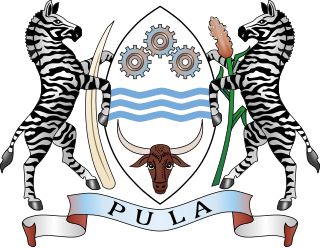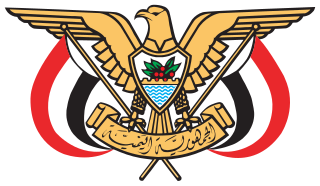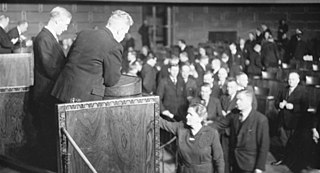
Elections in Botswana take place within the framework of a multi-party democracy and a parliamentary system. The National Assembly is mostly directly elected, and in turn elects the President and some of its own members. The Ntlo ya Dikgosi is a mixture of appointed, hereditary and indirectly elected members.

Federal elections were held in Germany on 12 January 1912. Although the Social Democratic Party (SPD) had received the most votes in every election since 1890, it had never won the most seats, and in the 1907 elections, it had won fewer than half the seats won by the Centre Party despite receiving over a million more votes. However, the 1912 elections saw the SPD retain its position as the most voted-for party and become the largest party in the Reichstag, winning 110 of the 397 seats.

General elections were held in Botswana on 15 October 1994, alongside simultaneous local elections. The result was a victory for the Botswana Democratic Party (BDP), which had won every election since 1965. However, the elections also saw a strong performance from the Botswana National Front (BNF), which tripled its number of MPs and won all four seats in the capital Gaborone.
Parliamentary elections were held in Finland between 1 and 3 July 1922. The Social Democratic Party remained the largest in Parliament with 53 of the 200 seats. The caretaker government of Professor Aimo Cajander (Progressive), that President Kaarlo Juho Ståhlberg had appointed in June 1922, following the resignation of Prime Minister Juho Vennola (Progressive), remained in office until Kyösti Kallio formed an Agrarian-Progressive minority government in November 1922. Voter turnout was 58.5%.

Parliamentary elections were held in Yemen on 27 April 1993, the first after Yemeni unification. The General People's Congress emerged as the largest party, winning 123 of the 301 seats. Voter turnout was 84.8%.

General elections were held in Sierra Leone Colony and Protectorate in November 1951.

Parliamentary elections were held in Iran on 15 April 1984, with a second round on 17 May. The majority of seats were won by independents, whilst the Islamic Republican Party was the only party to win seats. Voter turnout was 65.1% in the first round.

Parliamentary elections were held in Italian Trust Territory of Somaliland in February 1956. The result was a victory for the Somali Youth League (SYL), which won 43 of the 60 elected seats in the Territorial Council.

General elections were held in Bahrain for the first time on 12 December 1973. 30 seats out of the 44-seated unicameral National Assembly were contested, the other 14 were ex officio. Of the 24,883 registered voters, 19,509 cast a ballot, giving a voter turnout of 78.4%.

Parliamentary elections were held in Iraq on 9 June 1954, although they were delayed until 14 June in some areas due to social upheaval. The Constitutional Union Party remained the largest party in the Chamber of Deputies, winning 50 of the 135 seats, although 53 were won by independents. Despite the government creating obstacles for opposition candidates, they were described as "undoubtedly the freest elections in Iraqi history" in 2001.

General elections were held in Lebanon between 27 August and 3 September 2000 to elect the 128 members of the Parliament of Lebanon. Independent candidates won the majority of seats, although most of them were considered members of various blocs. Voter turnout was 40.5%.

Parliamentary elections were held in Syria were held between 30 November and 1 December 1998 to elect members of the People's Council of Syria, the unicameral parliament. The result was a victory for the Ba'ath Party, which won 135 of the 250 seats. Voter turnout was 82%.

Parliamentary elections were held in Laos on 25 December 1955 to elect members of the National Assembly, the lower chamber of Parliament. The result was a victory for the ruling National Progressive Party, which won 22 of the 39 seats. Voter turnout was 75.6%.

Parliamentary elections were held in Laos on 18 July 1965 to elect members of the National Assembly, the lower chamber of Parliament. The elections were boycotted by the Lao Patriotic Front, and saw the Southern Bloc emerge as the largest party with 15 of the 59 seats. However, only 22,000 citizens were allowed to vote, with the franchise restricted to politicians, civil servants, army officers, police and local government officers.
General elections were held in Siam on 15 November 1933 to elect 78 of the 156 members of the House of Representatives, with the other 78 appointed by King Prajadhipok. The elections were held on an indirect basis, with voters electing sub-district representatives between 10 October and 15 November, and the representatives then electing members of parliament on 16 November.
General elections were held in Siam on 7 November 1937 to elect 91 members of the 182-seat House of Representatives, with the other 91 appointed by King Ananda Mahidol. Unlike the 1933 elections, which had been carried out on an indirect basis, the 1937 elections were direct.
General elections were held in Siam on 29 January 1948. Following the 1947 coup, the unicameral parliament elected in 1946 was abrogated. It was replaced by a bicameral parliament with a 100-seat appointed Senate and a 99-member House of Representatives.

Indirect presidential elections were held in Finland in 1946. In 1944 the Parliament had passed a law that enabled Carl Gustaf Emil Mannerheim to serve a six-year term. However, he resigned on 4 March 1946, giving as his reason his declining health and his view that the tasks he had been selected to carry out had been accomplished. An election was held in Parliament to appoint his successor. Juho Kusti Paasikivi was elected with 159 of the 200 votes. Mannerheim had suffered from poor health since 1945, and he had vacationed abroad from November 1945 to January 1946. He had been concerned about the possibility of being indicted for abusing his office as the Commander-in-Chief of the Finnish army when approving of Finland's participation in the Continuation War (1941–1944) against the Soviet Union, and in an informal military alliance with Germany. He was not indicted, but eight leading wartime Finnish politicians were, and Mannerheim stayed abroad, mainly in Portugal, and on sick leave in the Red Cross's hospital in Helsinki from November 1945 to March 1946, to remain on the political background during the "war guilt" trial. Paasikivi was regarded by many Finnish politicians as the only realistic successor of Mannerheim, given his long diplomatic and foreign policy experience. Because many Karelian refugees would not yet have been able to vote in regular Finnish presidential elections until the autumn of 1946, due to their frequent changes of home town, the Finnish Parliament decided to pass an exceptional law to elect the new President. Former President K.J. Ståhlberg was not an official presidential candidate, but he received 14 sympathy votes in these presidential elections, because a few Finnish parliamentarians respected his preference for regular presidential elections.

Parliamentary elections were held in Portugal on 8 November 1925. The result was a victory for the Democratic Party, which won 83 of the 163 seats in the Chamber of Deputies and 39 of the 70 seats in the Senate. Following a military coup in 1926 and the subsequent Estado Novo period, the 1925 elections were the last truly multi-party elections in Portugal until the 1975 Constituent Assembly elections.

A by-election to the Spanish Cortes Españolas was held in Spanish Guinea in 1960.















